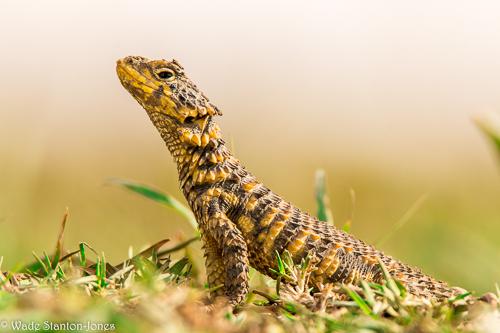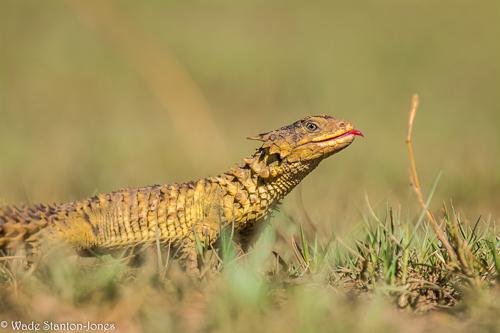Wade Keith Stanton-Jones
This study aims to assess which factors constrain burrow site selection in the Threatened girdled lizard, the Sungazer (Smaug giganteus). Specifically, it will assess the history of land management strategies and the effect that those strategies have had on Sungazer populations. Secondly, the microhabitat surrounding burrows will be assessed. The associated ecological benefits and consequences that individuals experience at their burrows will also be assessed. On a long-term scale, the population dynamics of previously PIT-tagged Sungazers will be assessed across four different study sites that have different conditions (two mine sites, an overgrazed rangeland and an undisturbed rangeland; McIntyre, 2006). This study will provide insight into a) how Sungazers select sites for burrow construction, b) how Sungazers interact with their environment, and c) future developments of conservation protocols.

Juvenile Sungazer. © Wade Stanton-Jones.
Sungazers (Smaug giganteus) are Threatened lizards that are endemic to the highveld grasslands of South Africa. These ambush foragers seek refuge in self-constructed burrows, where they spend most of their lives, and activity is concentrated around those burrows. It is evident that these lizards deserve their Threatened status as a recent assessment on the conservation status of the species reports an estimated 48% decline in mature individuals as compared to the historical population (Parusnath et al., 2017), with habitat fragmentation and poaching forming some of the major threats to the species. The anthropogenically-driven activities within the species’ distribution has the potential to affect the population structure and ecology of the species: as the human population increases, so does the pressure for agricultural land. In an attempt to combat the anthropogenically-driven pressures, previous attempts of translocation have been made but were extremely unsuccessful, with a 3% success rate in the year following translocation and a 0% success rate 10 years after. Sungazers are therefore imperilled because of the perfect storm: their habitat is disappearing, populations are decreasing and are being snuffed out, they are used in the muthi market, are in high demand in the pet trade, and they have poor translocation success rates. We predict that the lack of understanding on the microhabitat of the refuge sites and how the species interacts with its environment are contributing factors for the poor success rates of translocation, especially considering that Sungazers are a species that have strong selective pressures on choosing sites for burrow construction.

Post-feeding Adult - Tongue Exposed. © Wade Stanton-Jones.
Our research is aimed at assessing which factors drive burrow site selection in Sungazers. Additionally, we will be assessing the associated ecological benefits and consequences that Sungazers are exposed to whilst at their burrows. The results of this study are intended to enhance conservation efforts, with specific regard to translocation and reintroduction protocols as we aim to understand how Sungazers select sites for burrow construction, and how these lizards interact with their environment.